Abstract
In several high-energy astrophysical sites, shocks are assumed to produce a power-law distribution of accelerated charged particles (e.g., electrons, protons) and to generate mild to strong magnetic fields, which favours synchrotron emission. For such environments and conditions, we have performed and present here four practical formulas, with different levels of accuracy, for fitting the synchrotron spectral power radiated by a pure power-law particle distribution, with isotropic pitch angle distribution. The first three ones can be useful compared to the fourth one, because of their simplicity, in the case of particle distribution with no high-energy cutoff. However, the fourth formula, the more accurate one, can be of great interest for astrophysical applications (even though it is more complicated) for the more general case of a power-law distribution with high-energy sharp cutoff. The latter is derived for index p within the range, 1 < p < 6, with maximum relative error of less than 0.5 per cent in the case of infinite energy range and of less than 8.2 per cent in the more general case of particle energy with sharp cutoff. The latter is expressed in terms of parameters as functions of index p. These parameters have been fitted with adopting the Levenberg–Marquardt algorithm in log–log scale. According to these formulas, initially derived for the total spectral power, we have then derived (1) the degree of polarization, (2) cooling spectra for a broken power-law distribution and (3) synchrotron self-absorption spectra for both the broken and non-broken power-law distributions. The proposed expressions are relevant for non-thermal astrophysical sources in the sense that by using them one avoids usually complicated and long CPU time calculations, without performing any integration.
1 INTRODUCTION
Relativistic shocks such as those at work behind gamma-ray bursts (GRB), pulsar wind nebulae or active galactic nuclei and even non-relativistic ones as in supernova remnants (SNRs), are thought to be potential sources of particle acceleration in the universe (Gallant & Achterberg 1999; Spitkovsky 2008). Charged particles accelerated via these shocks are often described by a power-law distribution, with isotropic pitch angle distribution, of the type N(γ) = Cγ−p, in function of the Lorentz factor with sharp cutoff, i.e. γ1 < γ < γ2 (Fermi 1949; Blanford & Ostriker 1978; Gallant 2002; Petrosian & Bykov 2008), where the values of index p are however not well known although numerical simulations have led to typical values p ∼ 2.2-2.3 for relativistic shocks (see e.g. Gallant et al. 2000; Guthmann et al. 2000) and p = 2 for non-relativistic ones (Fermi 1949). This is possible in highly turbulent shocks usually dominated by intense magnetic fields (Ostrowski & Bednarz 2002). However, careful numerical simulations (Sironi, Spitkovsky & Arons 2013) have led to a particle distribution downstream the shock well described by a Maxwellian plus a non-thermal tail with slope of ∼2.4 ± 0.1 whose high-energy part can be adjusted by an exponential cutoff leading to the general form, N(γ) = Cγ− pexp( − γ/γc), with γ > γ1. Nevertheless, for our purpose in this paper, we have considered only a power-law distribution with sharp cutoff because of the simplicity of the corresponding analytical treatment, whereas the case of a power-law distribution with exponential cutoff that involves an additional parameter (γc) may be the subject of a future contribution. Then, we have considered index p values within the wide range, 1 < p < 6, surely containing values of astrophysical interest. The computation of the synchrotron spectral power from a power-law particle distribution (mainly electrons and protons) in astrophysical sites dominated by relativistic shocks can be made by numerical integration of the synchrotron function, F(x) (see equation 2), through the particle power-law distribution. To avoid performing complicated integrals (and then gain CPU time), we here propose an accurate analytical fit based on the asymptotic forms of the integrated spectral power for low- and high frequency values. In Section 2, we present the most adequate dimensionless form of the integrated spectral power together with corresponding asymptotic forms. Then, we report, in Section 3, the fit procedure used and the derived results. In Section 4, we present additional analytical fit related to the complementary synchrotron function, G(x), in order to treat the polarization. The derived result for the synchrotron self-absorption (SSA) is presented in Section 5. Then, we treat the case of a broken power law which is indispensable for cooling spectra in Section 6 before concluding in Section 7.
2 SYNCHROTRON POWER FROM A POWER-LAW PARTICLE DISTRIBUTION
The instantaneous (adiabatic) integrated synchrotron spectral power radiated by a pure power-law particle distribution with isotropic pitch angle distribution is written as (Rybicki & Lightman
1979)
where ν
L =
eB/2π
mc and ν
c ≡ ν
c(γ) = (3/2)γ
2ν
L are, respectively, the Larmor gyration frequency and the synchrotron characteristic frequency for a radiating charged particle with Lorentz factor γ, the usual quantities (
m,
e,
c and
B) denoting, respectively, the particle rest mass, its electric charge, the velocity of light in vacuum and the averaged strength of the perpendicular component of the magnetic field relative to the particle velocity direction. The synchrotron function,
F(
x), is given by (Westfold
1959; Jackson
1962; Rybicki & Lightman
1979)
in terms of the dimensionless frequency,
x ≡
x(γ) = ν/ν
c(γ), and the modified, non-integer order Bessel function,
K5/3(
x) (see e.g. Abramowitz & Stegun
1965). One notes that the synchrotron function expressed by equation (
2) is a pure classical result, valid for relativistic energies (γ ≫ 1) and magnetic field strengths below the quantum critical limit,
|$B_{ {\rm cr}}=m_{{\rm e}}^{2}c^{3}/e\hbar =4.41\times 10^{13}$| G, i.e.
B ≪
Bcr. In contrast, in the case of low energies, the synchrotron version is replaced by the cyclotron emission, and in the case of very strong magnetic field,
B ≳
Bcr, quantum electrodynamic effects must be incorporated (see e.g. Brainerd
1987; Brainerd & Petrosian
1987).
We first focus on the instantaneous (adiabatic) spectrum if all radiating particles are adiabatic and, then, cooling effects can be ignored. Indeed, instantaneous spectra are valid when the observation time-scale is much more lower than the synchrotron emission one, which can be the case, e.g., of SNRs and late afterglows following the GRB prompt emission. Then, cooling spectra can be easily deduced by just considering a broken power-law particle distribution, a case treated here in Section 6.
As we have shown previously (Fouka & Ouichaoui
2009,
2011), in formula (
1),
Pν can be expressed as
in terms of the parametric function
Fp(
x, η) with here
x = ν/ν
1 (where
|$\nu _{1}=(3/2)\gamma _{1}^{2}\nu _{{\rm L}}$|) and η = γ
2/γ
1, whereas the normalization coefficient,
P1, is given by
Besides, function
Fp(
x, η) can be split as (Fouka & Ouichaoui
2009)
for pointing out function
Fp(
x), which is of central interest in this work. This function can be expressed as (Fouka & Ouichaoui
2009)
It has the following asymptotic forms (Fouka & Ouichaoui
2009)
where (Rybicki & Lightman
1979; Fouka & Ouichaoui
2009)
in terms of the Gamma function and coefficient
|$F_{1}=\pi 2^{5/3}/\sqrt{3}\Gamma (1/3)$|.
3 ANALYTICAL FITS
In this section, we present and discuss four different possible analytical fits for functions Fp(x) and Fp(x, η) with different levels of accuracy.
3.1 The first form
This form is based on the simplest approximation of the synchrotron function,
F(
x), that can be written as
where
x0 is a specific value defined such that the area under the approximate form, noted
AF, is the same as that of the exact total area under function
F(
x). One obtains
AF = (4/9)Γ(1/3)Γ(2/3), leading to
x0 = (4
AF/3
F1)
3/4 ≈ 1.
Then, upon integration (see equation
6), one obtains the following approximate form for function
Fp(
x)
According to this expression and to equation (
7), the relative error (defined by, error = |
Fapprox −
Fexact|/
Fexact) for large
x-values (
x ≫ 1) is ∼1 − (κ
p/
Cp) which, e.g. for
p = 2.5, yields 13.8 per cent, whereas the maximum error, ≈85 per cent, is very large. Fig.
1 depicts the relative errors for this form (solid line) together with those associated with the three other following forms (presented in Sections
3.2–3.4) for index
p = 2.5.
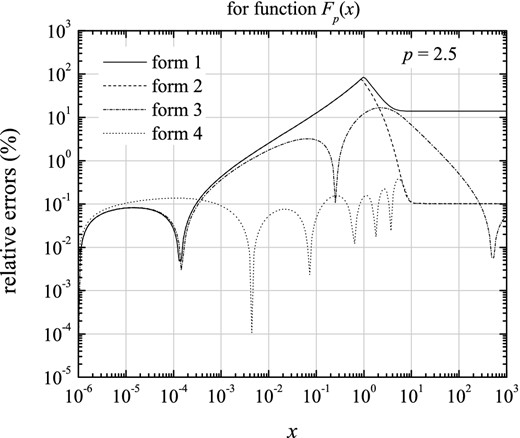
Figure 1.
The four relative errors associated with the proposed four fitting forms of Fp(x) for index p = 2.5: solid line for the first form (equation 10), dashed line for the second form (equation 12), dash–dotted line for the third form (equation 14) and dotted line for the fourth (more accurate) form (equation 16).
Then, according to equation (
5), the corresponding approximate form for function
Fp(
x, η) in the case of finite η is written as
The latter results in a sharp cutoff in the total spectrum above the frequency
x = η
2, and then to a relative error of 100 per cent, compared to the exact result. The corresponding relative error to this form is depicted in Fig.
6 (solid line), together with the three other following forms (presented in Sections
3.2–3.4) for index
p = 2.5 and η = 100. Consequently, in the case of particle distribution with sharp cutoff, this form can be used just for rapid estimation of spectra, but not for moderate or accurate calculations.
3.2 The second form
For this form, function
Fp(
x) is approximated by the first asymptotic form,
A1(
x), up to a value
xin and by the second asymptotic form,
A2(
x), behind
xin, i.e.
where
xin = (
Cp/κ
p)
2/(p − 1/3) is defined as the intersection abscissa of the two asymptotic forms. Values of index
p ∼ 3 give κ
p ∼
Cp and, then,
xin ∼ 1 for which this approximate expression (equation
12) becomes the same as the first one (equation
10). For this form, the maximum relative error for index
p = 2.5 is ≈77 per cent, which is slightly lower than that of the first form. However, as shown in Fig.
1, for index
p = 2.5, this form (dashed line) is better than the first form (solid line) for fitting the high-frequency range (
x ≫ 1), with lower relative error, ∼0.1 per cent, compared to that of the first form, ∼13.8 per cent.
Then, according to equation (
5), the corresponding approximate form for function
Fp(
x, η) in the case of finite η is written as
The latter is very similar to that of the first form. It results in a sharp cutoff above the frequency
x = η
2xin, leading to an error of 100 per cent for the range
x > η
2xin. It is therefore not recommended for moderate or accurate calculations, in the case of particle distribution with sharp cutoff.
3.3 The third form
This form is simply derived from the asymptotic forms of function
Fp(
x) and is given by
The maximum relative error corresponding to this form is ∼16 per cent. This form is better and more accurate compared to the two preceding ones, as can be clearly seen in Fig.
1 (dash–dotted line) for η = ∞.
Then, according to equation (
5), the corresponding approximate form for function
Fp(
x, η) in the case of finite η is written as
The latter form, corresponding to the general case of a particle distribution with sharp cutoff, is not sufficiently accurate, more especially for the high-frequency range,
x > η
2, for which the relative error increases significantly, as reported by Fig.
6.
This constitutes the main reason pushing us to look for more accurate fit formula with high/moderate accuracy (with a maximum relative error not exceeding few per cent) for all frequency ranges, and for any couple of (p, η) parameters with η ≳ 3 and index p in the range 1 < p < 6.
3.4 The fourth form
For this form, which is the most accurate compared to the preceding ones (even though it is more complicated), the central idea in fitting function
Fp(
x) is to express the latter in terms of its asymptotic forms as
where δ
1(
x) and δ
2(
x) are two arbitrary functions, which must verify the following respective limits, i.e.
and
As adequate forms of functions δ
1 and δ
2, we propose, respectively, the following expressions
and
Note that the same analytical fit procedure has been adopted by Fouka & Ouichaoui (
2013) to account for the synchrotron function,
F(
x), and its complementary function,
G(
x) =
xK2/3(
x). The index {
p/5 + 1/2} appearing in the expression of δ
2(
x) (see equation
20) has been found after numerical investigations aiming at obtaining the lowest possible values of the relative error for the whole range of index
p considered (i.e. 1 <
p < 6). In order to extract coefficients
ak and
bk for a given couple of orders (
n1,
n2), we proceeded by chi-squares minimization with adopting the Levenberg–Marquardt algorithm (Levenberg
1944; Marquardt
1963) in log–log scale and, then, considered coefficients
ak and
bk as functions of index
p, which has led us to an adequate and satisfactory result with
n1 = 3 and
n2 = 1. Each coefficient could be adjusted by a polynomial fit of order 3 or 4 to ensure a good accuracy in the general case when η is finite, according to equation (
5). These coefficients are given by
as polynomial fits, and plotted in Fig.
2 versus index
p. Then, the final fitting formula for function
Fp(
x) is written as
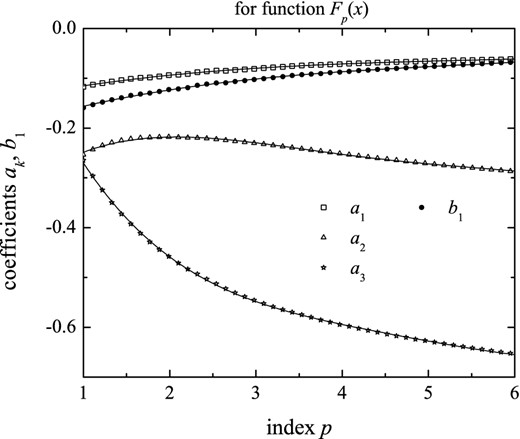
Figure 2.
Coefficients a1, a2, a3 and b1 as functions of index p, for function Fp(x), with corresponding polynomial fits reported by equation (21).
The maximum relative error resulting in fitting expression (22) to function Fp(x) is reported in Fig. 3 versus index p. The latter does not exceed 0.5 per cent, for the whole considered range of index p.
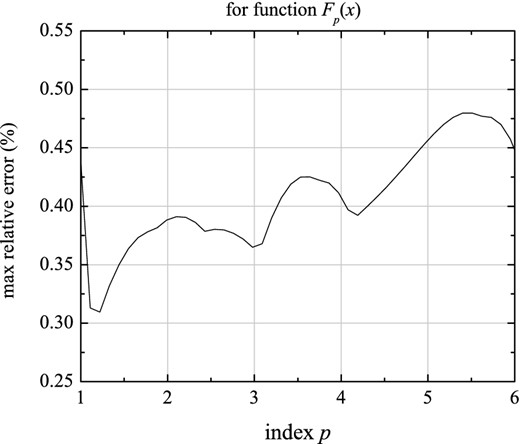
Figure 3.
The maximum relative error in fitting function Fp(x) versus index p, according to the fourth form (equation 22). This error does not exceed 0.5 per cent for the whole range of index p, 1 < p < 6.
As stated, one is concerned about calculating the radiated spectral power for a particle distribution with sharp cutoff, i.e. finite γ2. Indeed, function Fp(x) corresponds to the simplest case of infinite Lorentz factor, γ2 = ∞. Thus, in the general case, i.e. γ2 ≠ ∞, one has just to use equation (5) for calculating the spectral power.
However, in the general case (η ≠ ∞), function
Fp(
x, η) calculated from equations (
5) and (
22) takes on negative values for high frequencies,
x ≫ η
2. In order to solve this problem, we have used the asymptotic form of function
Fp(
x, η) for the frequency range
x ≫ η
2, given by (Fouka & Ouichaoui
2009,
2011)
where coefficient 55/72 is to be replaced by a coefficient
ap in order to improve the accuracy of the final approximate formula.
Finally, the more general fit formula for function
Fp(
x, η) is given by
where function
Fp(
x) can be calculated according to equation (
22) and the critical
xc-value corresponds to the approximate numerical solution of the equality
given with coefficient
ap, versus index
p, by
As an example, we report in Fig.
4 function
Fp(
x, η) (circles) for index
p = 2.5 and η = 100 together with the corresponding fit (solid line) according to equation (
24). According to equation (
24), the maximum relative error for function
Fp(
x, η) in the more general case (with η ≳ 3) is 8.2 per cent, as is reported by Fig.
5. For a given couple (
p, η), the maximum error is around
xc, as is reported in Fig.
6, for index
p = 2.5 and η = 100.
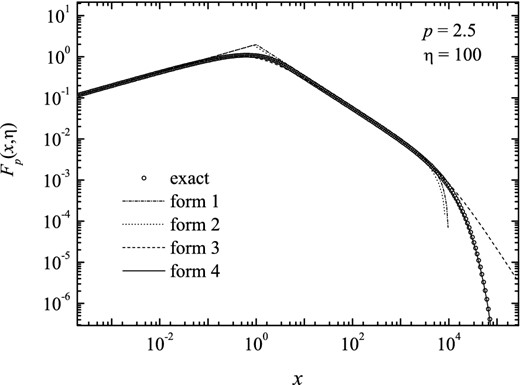
Figure 4.
Function Fp(x, η) for index p = 2.5 and η = 100, calculated numerically and adjusted according to the four forms.
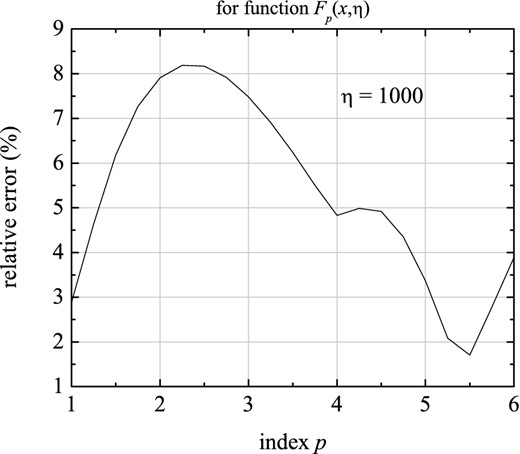
Figure 5.
The maximum relative error in fitting function Fp(x, η), versus index p, for η = 100, according to the fourth form (equations 22 and 24). It does not exceed 8.2 per cent, for 1 < p < 6 and η ≳ 3.
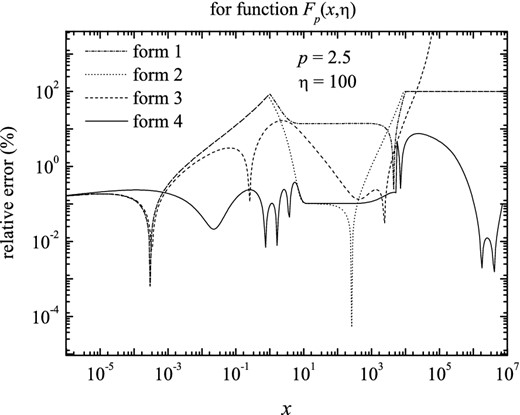
Figure 6.
The relative errors in fitting function Fp(x, η), for index p = 2.5 and η = 100, between the numerical computation of Fp(x, η) and the four approximate forms. This clearly reveals that the fourth form (equations 22 and 24) is the most accurate one for the whole frequency ranges (even though it is more complicated, compared to the other forms), and can then be used for astrophysical applications without any care. For p = 2.5, η = 100, the maximum error for the fourth form is <8.2 per cent.
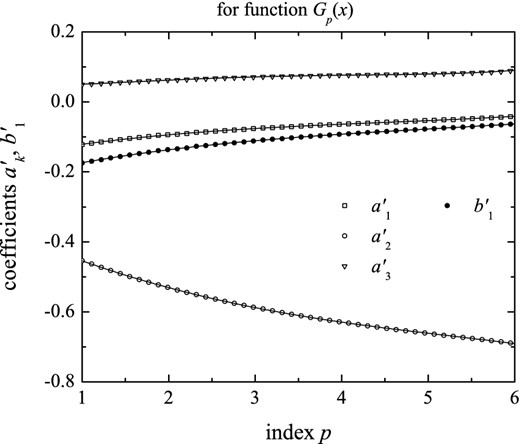
Figure 7.
Coefficients |$a^{\prime }_{1}$|, |$a^{\prime }_{2}$|, |$a^{\prime }_{3}$| and |$b^{\prime }_{1}$| as functions of index p for function Gp(x) with corresponding polynomial fits reported by equation (41).
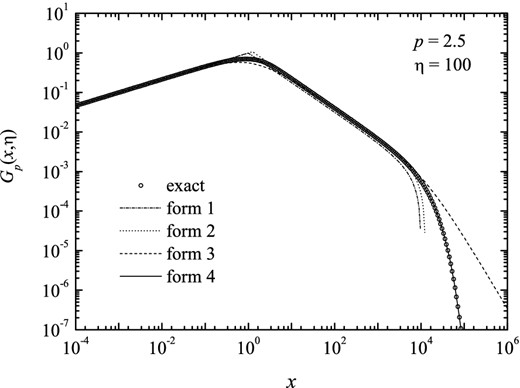
Figure 8.
Function Gp(x, η) for index p = 2.5 and η = 100, calculated numerically and adjusted according to the four forms.
4 DEGREE OF POLARIZATION
The degree of polarization is often an indispensable physical quantity that needs to be determined (computed and/or measured) in order to distinguish between radiation processes characterized by similar spectral shapes. It is defined by
where
|$P_{ \nu }^{\bot }$| and
|$P_{ \nu }^{\Vert }$| are, respectively, the radiated powers in the perpendicular and parallel directions relative to that of the magnetic field. For a power-law particle distribution with index
p and finite energy range (i.e. finite η), one has
where function
Gp(
x, η) is defined in similar way as function
Fp(
x, η) and can be written as
in terms of function
Gp(
x) given by
where
G(
x) =
xK2/3(
x) is the complementary synchrotron function (Westfold
1959) expressed in terms of the modified Bessel function
K2/3(
x). Function
Gp(
x) admits the following asymptotic forms (Rybicki & Lightman
1979)
with
where
G1 =
F1/2.
Then, in its general form the degree of polarization is written simply as
4.1 Approximate formulas for function Gp(x, η)
We first, present approximate formulas for function Gp(x), and then deduce those for function Gp(x, η). Indeed, function Gp(x) can be fitted using the same method adopted for function Fp(x), and can then be approximated by the forms described below.
4.1.1 The first form
This form is similar to that for function
Fp(
x) expressed by equation (
10), and is given by
whereas, for finite values of parameter η, it is written as
4.1.2 The second form
This form is similar to that for function
Fp(
x) expressed by equation (
12), and is given by
where
|$x^{\prime }_{ {\rm in}}=(C^{\prime }_{p}/\kappa ^{\prime }_{p})^{2/(p-1/3)}$| is defined as the intersection abscissa of the two asymptotic forms.
Then, according to equation (
29), the corresponding approximate form to function
Gp(
x, η) in the case of sharp cutoff is written as
4.1.3 The third form
This form is similar to that for function
Fp(
x) expressed by equation (
14), and is given by
Then, according to equation (
29), the corresponding approximate form for function
Gp(
x, η) in the case of finite η is written as
4.1.4 The fourth form
This form is similar to that for function
Fp(
x) expressed by equation (
22), and is given by
for which the resulting fit coefficients,
|$a^{\prime }_{1}$|,
|$a^{\prime }_{2}$|,
|$a^{\prime }_{3}$| and
|$b^{\prime }_{1}$|, are given by
as polynomial functions of index
p with 1 <
p < 6, and plotted by Fig.
7, whereas Fig.
8 depicts function
Gp(
x, η) calculated numerically and adjusted according to equation (42), for index
p = 2.5 and η = 100. The maximum relative error resulting in fitting expression (
40) to function
Gp(
x) is reported in Fig.
9 versus index
p. The latter does not exceed 0.6 per cent, for the whole considered range of index
p.

Figure 9.
The maximum relative error in fitting function Gp(x) versus index p, according to equation (40). This error does not exceed 0.6 per cent for the considered whole range of index p, 1 < p < 6.
Finally, similarly as we have shown for function
Fp(
x, η) (see equation
24), the more general fitting formula for function
Gp(
x, η) is given by
where function
Gp(
x) can be calculated, as was the case for function
Fp(
x), by equation (
40), with
|$x^{\prime }_{{\rm c}}$| and
|$a^{\prime }_{p}$| given by
Fig.
10 reports the relative errors in fitting function
Gp(
x, η), for index
p = 2.5 and η = 100, between the numerical computation of
Gp(
x, η) and the four approximate forms. It clearly reveals that the fourth form (equations
40 and
42) is the most accurate one for the whole frequency ranges (even though it is more complicated, compared to the other forms), and can then be used for astrophysical applications without any care [as mentioned above for function
Fp(
x, η)]. For
p = 2.5, η = 100, the maximum error for the fourth form is <2 per cent.

Figure 10.
The relative errors in fitting function Gp(x, η), for index p = 2.5 and η = 100, between the numerical computation of Gp(x, η) and the four approximate forms.
With the latter fitting formula (i.e. the fourth form), the maximum relative error is <0.6 per cent for function Gp(x) and <5 per cent for function Gp(x, η), in the more general case (with η ≳ 3), as is reported by Fig. 11.
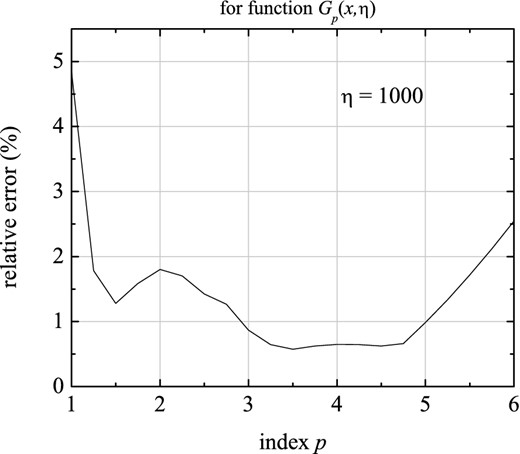
Figure 11.
The maximum relative error in fitting function Gp(x, η), versus index p, for η = 100, according to the fourth form (equations 22 and 24). It does not exceed 5 per cent, for 1 < p < 6 and η ≳ 3.
5 SYNCHROTRON SELF-ABSORPTION
Absorption effects for the same population of radiating particles lead to SSA spectral shapes (Rybicki & Lightman
1979). In this case, the specific intensity is given by
where τ
ν = α
νℓ and
Sν =
jν/α
ν are the optical depth and the source function, respectively, expressed in terms of the absorption coefficient α
ν (with ℓ being the dimension of the radiating zone) and the emission coefficient,
jν =
Pν/4π.
As we have shown in Fouka & Ouichaoui (
2009), the absorption coefficient, α
ν = α
1α
p(
x, η), and the source function,
Sν =
S1Sp(
x, η), can be expressed in terms of the dimensionless functions, and α
p(
x, η) and
Sp(
x, η), respectively, expressed in terms of function
Fp(
x, η) as
where coefficients α
1 and
S1 are written as (Fouka & Ouichaoui
2009)
Given that the two necessary quantities (α
ν and
Sν), for the computation of the SSA spectrum, are expressed explicitly in terms of function
Fp(
x, η), we have just to use the corresponding approximate forms to the latter, and, then, calculate α
ν and
Sν according to equation (
46). However, given that the forth fitting formula for function
Fp(
x, η) (equation
24) is valid for values of index
p within the range 1 <
p < 6, then, calculation of functions α
p(
x, η) and
Sp(
x, η) is valid for 1 <
p < 5. Fig.
12 reports the absorption coefficient α
p(
x, η), for index
p = 2.5 and η = 100, calculated numerically and adjusted according to the four forms. Figs
13 and
14 depict the relative errors corresponding to the four proposed forms, for α
p(
x, η) and
Sp(
x, η), respectively, with index
p = 2.5 and parameter η = 100. For the absorption coefficient, α
p(
x, η), the relative error reaches ∼100 per cent for frequencies
x ∼ 1 and for the high-frequency range
x > η
2, for the first and the second form, whereas for the third form it reaches ∼21 per cent for frequencies ∼0.47 and increases significantly (>100 per cent) for the high-frequency range,
x > η
2. Indeed, in order to calculate the specific intensity for SSA spectra, the accuracy of the absorption coefficient, which is argument of the exponential function (i.e.
|${\rm e}^{-\alpha _{\nu }\ell }$|), is highly recommended. This constitutes a strong reason to recommend the fourth approximate form for SSA spectra, for ensuring, at least, moderate accuracy for the specific intensity. Figs
15 and
16 depict, respectively, the specific intensity,
Iν, SSA(
x, η), and the corresponding relative errors, for index
p = 2.5 and η = 100, calculated numerically and adjusted according to the four forms.

Figure 12.
The absorption coefficient, in terms of function αp(x, η), for index p = 2.5 and η = 100, calculated numerically and adjusted according to the four forms.
![The relative errors in fitting function αp(x, η), for index p = 2.5 and η = 100, between the numerical computation and the four approximate forms [derived from those of function Fp(x, η)]. One remarks clearly that the fourth form [corresponding to that of function Fp(x, η); equations (22) and (24)] is the most accurate and valuable one for the whole frequency ranges. For p = 2.5, η = 100, the maximum error for the fourth form is <5 per cent.](https://oup.silverchair-cdn.com/oup/backfile/Content_public/Journal/mnras/442/2/10.1093/mnras/stu922/2/m_stu922fig13.jpeg?Expires=1749871233&Signature=Ig1nThtc8bdcCGWewXqPH46wGmEmwdNgEswad1goEjvdjJxAqJZZrN4o-3qq8f-rervwFEFJT2HL1dCUwz9SN5MS5SdU1PADL3X0HalgLkIYdLcGmIDIpp14C4~DznD6rIkwxS6UlXYQRRB7z7qVTREt~Mdy9hUlT7vryJsQVDHTO1N2PxD9sCaBF8~XacfxAyqxH8a5E3iOXNsBTrDqLVhHi9ia0vdDWT6-dzFZ0rCGwRtSwTs5Tkj4biV1AZ0cv2lR2pjHOv5~kaqJ2YKo8ddYkQ6L3q~mcqeGE7dme8oYSF5fIBroBpjh1um0bMCTm4LF4LAru~egY7U-vdTcYA__&Key-Pair-Id=APKAIE5G5CRDK6RD3PGA)
Figure 13.
The relative errors in fitting function αp(x, η), for index p = 2.5 and η = 100, between the numerical computation and the four approximate forms [derived from those of function Fp(x, η)]. One remarks clearly that the fourth form [corresponding to that of function Fp(x, η); equations (22) and (24)] is the most accurate and valuable one for the whole frequency ranges. For p = 2.5, η = 100, the maximum error for the fourth form is <5 per cent.
![The relative errors in fitting function Sp(x, η), for index p = 2.5 and η = 100, between the numerical computation and the four approximate forms [derived from those of function Fp(x, η)]. This clearly reveals that the fourth form [corresponding to that of function Fp(x, η); equations (22) and (24)] is the most accurate and valuable one for the whole frequency ranges. For p = 2.5, η = 100, the maximum error for the fourth form is <4.1 per cent.](https://oup.silverchair-cdn.com/oup/backfile/Content_public/Journal/mnras/442/2/10.1093/mnras/stu922/2/m_stu922fig14.jpeg?Expires=1749871233&Signature=J93Vv8N9DqjxTiS8UWtyQPutfnoK1vh4UfxgRilxrov8LWhudN2Kl~iE05hJVPwy4bOZekLnPDM1p26w50wnZaqnrknbrghEQeSreo54BymJn0pgEQZWZZJx8qaCBEBhpxrDYTeXZKlk1wDZfb49ydV0RMssGixBsT2TfrwbR0sro-mF0R-b~2toNb0AHPTdvot44Jk2zM7PxhXuw6oVjZDwwHLlQY4XV6OKZOxjfVE2g0q0pIzlgBhYm5lLoAqdm~8p1Z165HiXaD56reAwQVzJwZwiNyPja7L4LMNTUZbtDPgpUpCmydjN21LuA9MeRmAkVoPSXNRCG7I5tAus~A__&Key-Pair-Id=APKAIE5G5CRDK6RD3PGA)
Figure 14.
The relative errors in fitting function Sp(x, η), for index p = 2.5 and η = 100, between the numerical computation and the four approximate forms [derived from those of function Fp(x, η)]. This clearly reveals that the fourth form [corresponding to that of function Fp(x, η); equations (22) and (24)] is the most accurate and valuable one for the whole frequency ranges. For p = 2.5, η = 100, the maximum error for the fourth form is <4.1 per cent.
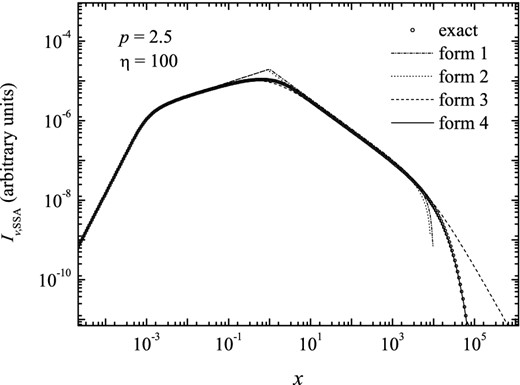
Figure 15.
The specific intensity, Iν, SSA(x, η), for index p = 2.5 and η = 100, calculated numerically and adjusted according to the four forms. The latter shows a good concordance between the forth form and the exact calculation.
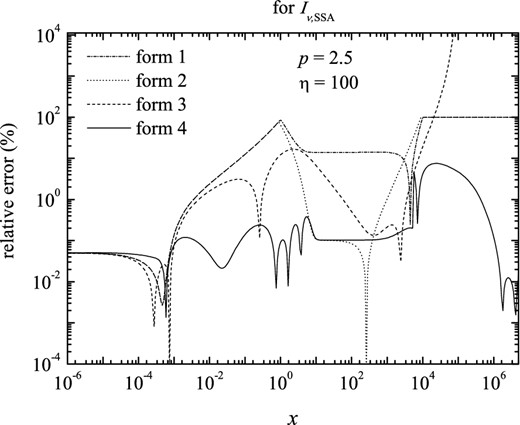
Figure 16.
The relative errors in fitting the specific intensity, Iν, SSA, for index p = 2.5 and η = 100, between the numerical computation and the four approximate forms.
Note that this result holds in the instantaneous (adiabatic) emission regime where cooling effects are absent or, at least, can be ignored. In this case, the particle distribution is characterized by just one index value. In contrast, the treatment is different in the case of a broken power-law particle distribution. This case is presented late in the next section.
6 CASE OF BROKEN POWER-LAW DISTRIBUTION: COOLING SPECTRA
Under conditions where the synchrotron cooling time-scale is lower than the dynamical time-scale inside the emitting region, the power-law index of radiative particles with Lorentz factor γ > γ
c (γ
c being a characteristic value differentiating between radiative and cooling particles) is increased by unity, i.e.
p →
p + 1. In such conditions, two situations are possible for particles with Lorentz factor γ
1 < γ < γ
2 : (i) the case γ
c < γ
1 for which all particles are radiative, called ‘
fast cooling regime’ and (ii) the case γ
1 < γ
c < γ
2 for which particles with γ
1 < γ < γ
c are adiabatic and those with γ
c < γ < γ
2 are radiative, called ‘
slow cooling regime’. For the first case, the particle energy distribution becomes
N(γ) =
C′γ
−(p + 1) without break, and can then be treated just with replacing index
p by
p + 1 in all fitting formulas presented above. Besides, for the second case corresponding to the slow cooling regime, the particle distribution takes on the form
with
C2 =
C1γ
c.
Then, the total spectral power can be easily deduced and is written as
with
Then, in the case of a broken power-law particle distribution, corresponding to the slow cooling regime, the total spectral power can be written as
Pν =
P1Fp(
x, η
1, η
2), with
x = ν/ν
1, and function
Fp(
x, η
1, η
2) is written as
Figs
17 and
18 depict, respectively, function
Fp(
x, η
1, η
2), and the corresponding relative errors, for index
p = 2.5, η
1 = 100 and η
2 = 100, calculated numerically and adjusted according to the four forms.
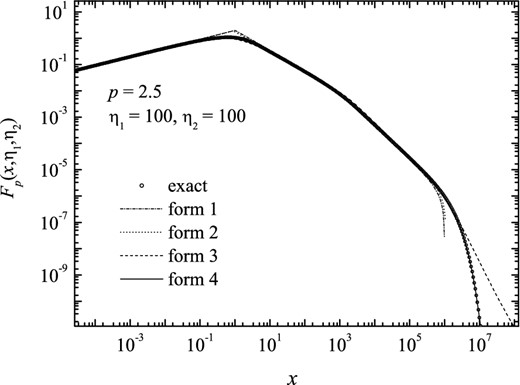
Figure 17.
The synchrotron spectral power in the case of a broken power-law particle distribution, in terms of function Fp(x, η1, η2) defined by equation (50), for index p = 2.5 and η = 100, calculated numerically and adjusted according to the four forms. The latter shows a good concordance between the forth form and the exact calculation.
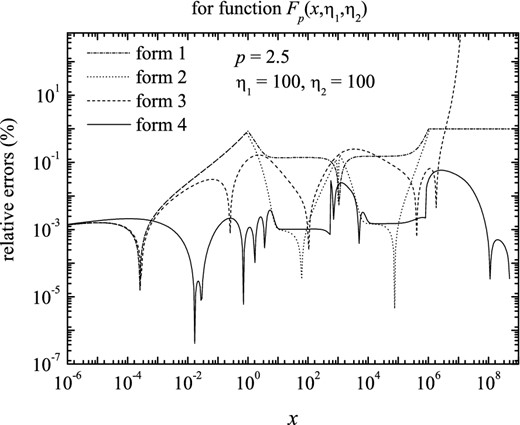
Figure 18.
The relative errors in function Fp(x, η1, η2), in the case of broken power-law particle distribution, for index p = 2.5 and parameters η1 = 100, η2 = 100.
In order to calculate the SSA spectrum for a broken power-law particle distribution, we must express the absorption coefficient in its general formula, i.e. (Rybicki & Lightman
1979)
Then, according to equation (
47), one obtains
with
where ν
i and η
i are the same as defined in equation (
49). After simplifications, the absorption coefficient can be written as α
ν = α
1α
p(
x, η
1, η
2), with the extended function α
p(
x, η
1, η
2) given by
and, finally, the source function can be easily derived and be written as
Sν =
S1Sp(
x, η
1, η
2), with
S1 =
P1/4πα
1, and function
Sp(
x, η
1, η
2) is written simply as
7 SUMMARY AND CONCLUSION
In this work, we have presented and compared four approximate formulas for the synchrotron radiation, for both optically thin and self-absorbed emission, and for both non-broken and broken power-law isotropic particle distributions. For this purpose, we have first presented a general fit formula for the instantaneous (adiabatic) synchrotron spectral power radiated by a pure power-law particle distribution with isotropic pitch angle distribution. In order to derive a more general and accurate expression, we have considered a wide range of index p values, i.e. 1 < p < 6. The central idea was to use the known asymptotic forms of the synchrotron spectral power that were multiplied by functions δ1(x) and δ2(x) expressed in adequate forms and depending on adjustable parameters. We have proceeded by the Levenberg–Marquardt algorithm in log–log scale in order to extract adjustable fit parameters for a given value of index p. After obtaining the adjustable parameters as functions of index p, we have generated polynomial fits of order 3 or 4 in order to account for their variations. We have shown that the relative error does not exceed 0.5 and 0.6 per cent, respectively, for functions Fp(x) and Gp(x), for the considered whole range of index p. In the general case of a particle distribution with sharp cutoff, one has to calculate function Fp(x, η) given by equation (5) in terms of function Fp(x). We have shown that according to the latter (equation 5), the relative error is increasing for frequencies x ≫ η2, a problem that can be easily solved by considering the modified analytical asymptotic form (derived earlier by us) for this range. Then, we have deduced fit formulas for the degree of polarization and the SSA. We have also treated the case of cooling spectra corresponding to a particle distribution with broken power law. This has led us directly to infer the integrated spectral power, the SSA absorption coefficient and the source function with avoiding the computation of the synchrotron function, F(x) or the complementary synchrotron function G(x) and their integration under the particle distribution. We estimate that the proposed fit expressions are very useful and practical, at least for high-energy astrophysical sites involving relativistic shocks.
We would like to deeply thank the referee for his pertinent remarks and recommendations that helped us to considerably improve the content of the initial manuscript. This work was supported by the General Direction of Scientific Research and Technological Development (GDSRTD) of Algeria within the framework of the National Research Projects (NRP).
REFERENCES
,
Handbook of Mathematical Functions
,
1965
New York
Dover Press
pg.
374
,
ApJ
,
1978
, vol.
221
pg.
L23
,
ApJ
,
1987
, vol.
320
pg.
714
,
ApJ
,
1987
, vol.
320
pg.
703
,
Phys. Rev.
,
1949
, vol.
75
pg.
1169
,
ApJ
,
2009
, vol.
707
pg.
278
,
ApJ
,
2011
, vol.
743
pg.
89
,
Res. Astron. Astrophys.
,
2013
, vol.
13
pg.
680
,
Lecture Notes in Physics, Vol. 598, Relativistic Flows in Astrophysics
,
2002
Berlin
Springer
pg.
24
,
MNRAS
,
1999
, vol.
305
pg.
L6
,
AIP Conf. Proc. Vol. 526, Gamma Ray Bursts
,
2000
New York
Am. Inst. Phys.
pg.
524
,
AIP Conf. Proc. Vol. 526, Gamma Ray Bursts
,
2000
New York
Am. Inst. Phys.
pg.
485
,
Classical Electrodynamics
,
1962
New York
Wiley
,
Q. Appl. Math.
,
1944
, vol.
4
pg.
164
,
J. Soc. Ind. Appl. Math.
,
1963
, vol.
11
pg.
431
,
A&A
,
2002
, vol.
394
pg.
1141
,
Space Sci. Rev.
,
2008
, vol.
134
pg.
207
,
Radiative Processes in Astrophysics
,
1979
New York
Wiley
,
ApJ
,
2013
, vol.
771
pg.
54
,
ApJ
,
2008
, vol.
673
pg.
L39
,
ApJ
,
1959
, vol.
130
pg.
241
© 2014 The Authors Published by Oxford University Press on behalf of the Royal Astronomical Society
PDF










![The relative errors in fitting function αp(x, η), for index p = 2.5 and η = 100, between the numerical computation and the four approximate forms [derived from those of function Fp(x, η)]. One remarks clearly that the fourth form [corresponding to that of function Fp(x, η); equations (22) and (24)] is the most accurate and valuable one for the whole frequency ranges. For p = 2.5, η = 100, the maximum error for the fourth form is <5 per cent.](https://oup.silverchair-cdn.com/oup/backfile/Content_public/Journal/mnras/442/2/10.1093/mnras/stu922/2/m_stu922fig13.jpeg?Expires=1749871233&Signature=Ig1nThtc8bdcCGWewXqPH46wGmEmwdNgEswad1goEjvdjJxAqJZZrN4o-3qq8f-rervwFEFJT2HL1dCUwz9SN5MS5SdU1PADL3X0HalgLkIYdLcGmIDIpp14C4~DznD6rIkwxS6UlXYQRRB7z7qVTREt~Mdy9hUlT7vryJsQVDHTO1N2PxD9sCaBF8~XacfxAyqxH8a5E3iOXNsBTrDqLVhHi9ia0vdDWT6-dzFZ0rCGwRtSwTs5Tkj4biV1AZ0cv2lR2pjHOv5~kaqJ2YKo8ddYkQ6L3q~mcqeGE7dme8oYSF5fIBroBpjh1um0bMCTm4LF4LAru~egY7U-vdTcYA__&Key-Pair-Id=APKAIE5G5CRDK6RD3PGA)
![The relative errors in fitting function Sp(x, η), for index p = 2.5 and η = 100, between the numerical computation and the four approximate forms [derived from those of function Fp(x, η)]. This clearly reveals that the fourth form [corresponding to that of function Fp(x, η); equations (22) and (24)] is the most accurate and valuable one for the whole frequency ranges. For p = 2.5, η = 100, the maximum error for the fourth form is <4.1 per cent.](https://oup.silverchair-cdn.com/oup/backfile/Content_public/Journal/mnras/442/2/10.1093/mnras/stu922/2/m_stu922fig14.jpeg?Expires=1749871233&Signature=J93Vv8N9DqjxTiS8UWtyQPutfnoK1vh4UfxgRilxrov8LWhudN2Kl~iE05hJVPwy4bOZekLnPDM1p26w50wnZaqnrknbrghEQeSreo54BymJn0pgEQZWZZJx8qaCBEBhpxrDYTeXZKlk1wDZfb49ydV0RMssGixBsT2TfrwbR0sro-mF0R-b~2toNb0AHPTdvot44Jk2zM7PxhXuw6oVjZDwwHLlQY4XV6OKZOxjfVE2g0q0pIzlgBhYm5lLoAqdm~8p1Z165HiXaD56reAwQVzJwZwiNyPja7L4LMNTUZbtDPgpUpCmydjN21LuA9MeRmAkVoPSXNRCG7I5tAus~A__&Key-Pair-Id=APKAIE5G5CRDK6RD3PGA)









